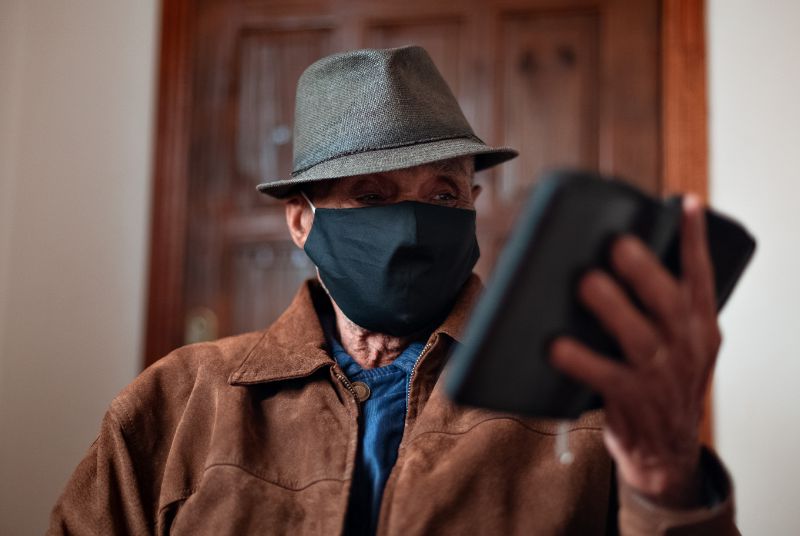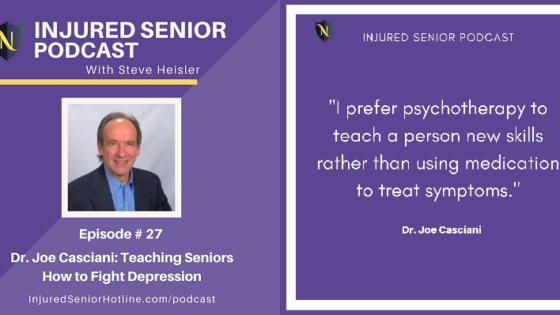Joe Casciani, PhD
There are realistic concerns for older adults about the risk of becoming infected with the corona virus. This is not due to being older per se, but mostly due to a higher incidence of weakened immune systems and the presence of so many medical co-morbidities. But, among many seniors, there is also the possibility of becoming overwhelmed with fear of infection, hospitalization, and even death if one becomes infected. What is the best mindset to cope with this distress? How do we manage our fear of becoming infected without relying on denial or completely isolating ourselves? Successful management requires us to be open to all possibilities – without expecting the worst. We all want to stay healthy, but how do we do this, and can we stay healthy without shutting out the world or being overcome with worry?
This article offers little bit of guidance about risk management, including the latest statistics on mortality for older adults, necessary precautions, and how to prioritize problem solving over worry for the senior population.
The Facts on Mortality Rates
As of September 22, 2020, 79% of all deaths reported in the US are in the 65 and over population and totaled 113,623 deaths. This rate represents approximately 8 out of every 10 deaths in the U.S. are occurring in those 65 and older – a serious and highly disproportionate number. (The breakdown by setting for older adults deserves its own article due to the higher incidence of elderly deaths taking place in nursing homes. Follow these links for further guidance on addressing COVID-19 in retirement communities and nursing homes). Further information on the rates of mortality by race, age, and gender are available on the Centers for Disease Control and Prevention, see Older Adults and COVID-19 and Cases and deaths by race, age, and gender.
We have known for many months that the risk for severe illness from COVID-19 increases with age, including need for hospitalization, intensive care, and unfortunately, death. This is due to weaker immune systems and the increased incidence of medical co-morbidities. The five most prominent medical comorbidities include chronic kidney disease, chronic obstructive pulmonary disease (COPD), heart disease, diagnosed diabetes, and obesity. In the presence of advancing age or medical conditions, the older adult is well advised to take additional precautions. These additional precautions are discussed in more detail below.
Further complicating this are-related risk is when seniors are living alone or are more socially isolated, leaving them with limited resources, reduced access to factual information from newspapers and other media, and no relatives or friends offering help and reassurance. With less information at their fingertips, they may be even more prone to worry, unrealistic thinking, and misinformed decision-making.
Deciding to Go Out More
At some point, we want to go out more and resume some semblance of pre-pandemic way of life. However, it is impossible to ensure zero risk of infection by resuming activities, running errands, or attending religious or social events. Because there are risks of going out, especially for the older adult, these are the most important factors to help you make an informed decision about leaving your home or apartment:
- Is the virus spreading in your community? Check here to see trends by State and County.
- Could you have possible contact with someone who is sick or may not be wearing a mask?
- Are you at increased risk from a compromised immune system or other medical condition?
- Do you follow recommended precautionary steps on a daily basis?
- How many people will you interact with if you do venture out?
- Will they be wearing masks and are they likely following proper precautions?
- Can you practice social distancing (6-feet separation)?
- Will you be indoors or outdoors (less risk)?
- Will you be spending an extended amount of time with people when out?
- Will you have to share items with others (equipment, tools, utensils)?
- Do you need to use public transportation to travel?
The answers to these questions should guide your decisions to resume usual activities. Like a game of Russian roulette, think of these risk factors like bullets in a gun: are there enough empty chambers to make a sound, informed decision?
Following Healthy Precautions Against the Risk of Coronavirus Infection
Following guidelines from the CDC for older adults, these are the latest facts and recommendations for reducing the risk of infection from the corona virus.
- The best way to prevent the illness is to avoid being exposed to it. It is spread from person to person, in close contact with one another, through respiratory droplets when an infected person coughs, sneezes, or even talks. The droplets may land in our mouth, or nose, or may be breathed in. The virus may even be spread by asymptomatic people.
- Maintain social distance (6 feet = 2 arms lengths).
- Wash your hands often.
- Routinely clean and disinfect surfaces daily using recommended household disinfectants (doorknobs, light switches, countertops, handles, phones, keyboards, faucets and sinks).
- Cover your mouth and nose with a mask in public settings and when around people not living in your household. Masks should not be used on children under 2 years, anyone who has trouble breathing, or is unconscious, incapacitated, or otherwise unable to remove a mask without assistance.
- The virus may be spread by touching a contaminated surface or object and then touching your face, mouth, eyes, or nose.
- Cover your coughs and sneezes with a tissue or inside of your elbow, and do not spit. Immediately throw tissues in trash and follow up with hand washing for at least 20 seconds.
- Monitor possible symptoms like fever, cough, shortness of breath, or other symptoms. See CDC’s Symptom Checker at this link for comprehensive list of symptoms to watch for.
- If you are sick, stay home (except to get medical care), and separate yourself from other people. Use a separate bathroom (if possible)
- Inform close contacts they may have been exposed to the corona virus since the virus can be spread up to two days before the onset of symptoms or before the carrier tests positive.
What are Common Emotional Reactions to the COVID-19 Pandemic?
Concern about possibly contracting the virus, and infecting others if you are infected is healthy and a sign of good judgement. Emotions during this 10-month period pandemic run the full gamut. We all are worried about our own health and that of our loved ones, friends, and neighbors. Could we lose our support system, or our financial stability if we get sick? Who will pay for our care if we do not have good health insurance, and what about just getting tested – is it reliable and timely? Sadness and frustration about separation from our social network are common, as is anger at government-sponsored “lockdowns” and an inability to socialize, dine out, and carry on a normal life. We may see changes in our sleep and eating patterns, and weight gain is unfortunately too common (Quarantine 15). It is also expected to see a worsening of our chronic health conditions, as well as an increase in tobacco, alcohol, and other substances. These are common responses to stress.
The Art of Coping
There is a difference between emotion-focused coping and solution-focused coping. How we perceive and interpret an unpleasant event will largely determine how successful we are in managing the stress from it. There are two ways of coping. Emotion-focused coping is attempting to manage a situation through emotions, and usually means allowing our fear and anxiety and worry to take over our response to stress. Feeling as though things are out of control, expecting the worst, having a pessimistic future outlook, and seeing oneself as immobilized and helpless are all ineffective coping strategies. We have to remember there is a huge difference between worrying and problem solving. If we do not have the answers to how to manage things, we worry more and imagine the worst. Uncertainty leads to more worry.
Problem solving, or problem-focused coping involves controlling what we can, like our judgement, our actions and reactions, and our self-care. It is usually aimed at resolving the stressful situation, shifting the way we see the problem, or attempting to work with the stressor itself.
- Taking steps to be active – physically and mentally – is one way to manage this external stress.
- Learning more about the stress and the strategies to prevent virus infection is another way.
- Giving ourselves a time limit on worrying will help.
- Avoiding social isolation, within recommended guidelines, is a proactive coping mechanism.
- Our problem solving skills go up when we reach out to help others, whether by phone or email, or in person when practical and safe.
- Checking on our neighbors and supplying them with health information and guidelines is also recommended. Resources that are available for download, printing, and sharing with others include 10 Things to do to Manage COVID-19 Symptoms at Home, How to Protect Yourself and Others, and What You Need to Know about COVID-19 and Pets.
- When experiencing a new symptom like a cough, consider CDC recommendations on what to do when you feel sick and when to seek medical care.
- Follow through on mindfulness and breathing exercises, and other tips on reducing anxiety.
- Practice good self-care activities including diet, sleep, and exercise.
- Monitor your own health status with a self-report of symptoms using the CDC Symptom Checker.
What problem-focused coping is really all about is taking action and seeing oneself as capable and effective. When we look at the big picture and focus on doing things, we are better at managing our stress and much better at limiting our worry.
Closing
COVID19 has slammed the lives and livelihoods of millions of people around the world. It is a catastrophe unlike any seen in generations. Staying vigilant about becoming infected with the virus is healthy and warranted, especially for older adults. But it is also important to avoid unnecessary worrying and forming negative or pessimistic mindsets about this pandemic. Instead, I believe we need to learn the facts, stay informed by using the many public resources available (like the links provided here, including the CDC’s FAQs page), taking all of the necessary precautions, and staying positive about making it through this very difficult moment in time.





